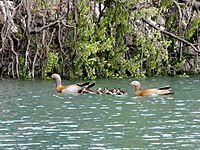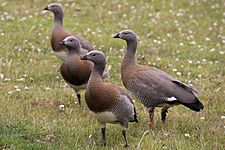Ashy-headed goose facts for kids
Quick facts for kids Ashy-headed goose |
|
|---|---|
 |
|
| Adult in Patagonia, South America | |
| Conservation status | |
| Scientific classification | |
| Genus: |
Chloephaga
|
| Species: |
poliocephala
|
 |
|
The ashy-headed goose (Chloephaga poliocephala) is a type of waterfowl, which means it's a bird that lives near water. It belongs to a group of birds called Tadornini. You can find this goose in Argentina and Chile in South America. It's named for its gray head!
Contents
About the Ashy-Headed Goose
The ashy-headed goose is a special kind of bird. It's considered monotypic, which means it's the only species in its specific group. This makes it quite unique!
What Does the Ashy-Headed Goose Look Like?
The ashy-headed goose is about 50 to 60 centimeters (about 20 to 24 inches) long.
- Males weigh between 1.62 and 2.27 kilograms (about 3.6 to 5 pounds).
- Females are a bit lighter, weighing 1.47 to 1.49 kilograms (about 3.2 to 3.3 pounds).
Both male and female adult geese look very similar.
- Their heads and necks are gray.
- Their upper back and chest are a reddish-brown color with thin stripes.
- Their sides have black and white stripes.
- Their belly is white.
When they fly, you can see their dark wings. These wings have bright white patches on the front and back edges. They also have a shiny green patch called a speculum. Their beak is black, and their legs and feet are orange with black marks.
Young geese look a bit different. Their reddish-brown areas are not as bright. The stripes on their back and chest are much stronger. Their green wing patch is a dark brownish color.
Where Does the Ashy-Headed Goose Live?
The ashy-headed goose lives in the southern part of South America. You can find it from central Chile and the Buenos Aires Province in Argentina, all the way south to Tierra del Fuego. Sometimes, these geese also visit the Falkland Islands. They have even raised their young there!
In the summer, they like to live in clearings within damp forests. These forests often have southern beech trees. They prefer areas around lakes and marshes, on islands, near the coast, or on higher ground. In the winter, they move to open fields and pastures.
How Does the Ashy-Headed Goose Behave?
Moving Around: Migration
The ashy-headed goose builds its nests south of 37 degrees south latitude. This includes parts of Chile and western Argentina. When winter comes, many of these geese travel further north. They go to other parts of Chile and to the Pampas region of Argentina. This journey helps them find warmer places and more food.
What Do They Eat?
The ashy-headed goose eats mostly plants. They are almost entirely vegetarian!
- In winter, they often feed in fields where crops like wheat, corn, sunflower, and sorghum have been harvested.
- During the summer in Tierra del Fuego, they eat leaves and juicy fruits. A favorite fruit is the red crowberry.
How Do They Raise Their Young?
The breeding season for the ashy-headed goose starts in October or November. In some places, it can last until March.
- They build their nests alone or in small, spread-out groups.
- Nests can be in a tree hollow, on a tree stump, or hidden in tall grass.
- They line their nests with soft down feathers.
- A female goose usually lays four to six eggs.
- The male goose guards the female while she sits on the eggs. This incubation period lasts about 30 days.
- We don't know exactly how long it takes for the young geese to be ready to fly.
What Sounds Do They Make?
Male and female ashy-headed geese make different sounds.
- Males make soft, whistling sounds.
- Females make harsh, cackling noises.
Is the Ashy-Headed Goose Safe?
The IUCN (International Union for Conservation of Nature) has looked at the ashy-headed goose. They have decided it is a species of "Least Concern." This means they are not worried about it becoming endangered soon.
- The goose lives across a very large area.
- Even though we don't know the exact number of geese, their population seems to be stable.
- There are no big threats to them right now.
Surveys in northeastern Argentina during winter have estimated that as many as 150,000 geese might be there. In their breeding areas, people generally leave them alone. However, in winter, farmers sometimes see them as a problem for their crops.
Gallery
See also
 In Spanish: Cauquén cabeza gris para niños
In Spanish: Cauquén cabeza gris para niños





